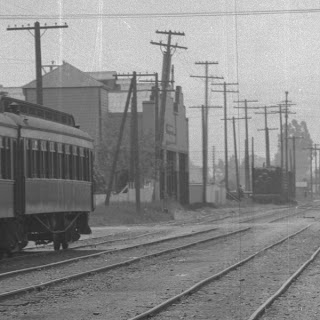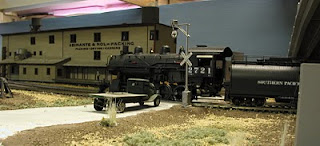Early on in the planning for my Vasona Branch model railroad layout, I poked through old Sanborn fire insurance maps for ideas about industries. One of my finds was a dried fruit packing house next to the tracks at
750 West San Carlos St. in San Jose. It sat across the street from Del Monte Plant #3, the huge cannery in San Jose that I was already planning to model. Depending on the year, the building was either labeled as Pacific Fruit Products (1915) or Abinante and Nola (1950).
The
Sanborn maps hinted at a building that would make a great model: tall (30'), multiple floors for processing fruit, additions (sulphur box on the second floor), and a boiler and oil tank along San Carlos St. Model railroads need lots of industries to ship enough cars to make an operating system fun, and this place looked like the kind of shipper I needed on my railroad - busy, rambling, and photogenic.
The Vasona Branch is modeling 1932, but at the time I didn't know whose name should be on that building. I flipped a coin,
annointed Abinante and Nola the current owner, built my model, and many crews have shipped dried fruit from the place ever since.
But I was still curious about Abinante and Nola. What did the building really looked like? How did the dried fruit packing business work? There's a reason for my curiosity; my grandmother grew up on the family fruit ranch in Hayward, and similar families in the San Jose area would have been selling apricots and prunes to Abinante and Nola and the other local packers. So I kept searching around for information about that packing house.
Luckily, I started trading e-mails with Don Abinante, son of one of the founders, and learned a bunch about dried fruit packing. Here's a quick history of Abinante and Nola, and some quick notes on what the business was really like (as opposed to how it appears on the
model railroad.)
Abinante and Nola's History: Abinante and Nola actually was founded a bit after the era for my railroad. Abinante and Nola Packing Co. was started in 1935 by Sam Abinante and Frank Nola. Sam had been a fruit buyer for other companies in the Valley, and Frank knew how to run the processing plant, so they teamed up, started the business in a barn owned by Frank's parents, and ran their own show.
By 1940, they must have been doing well. They moved to a new property on Stevens Creek Road,
a couple blocks away from the current Nissan dealership. (If you're eager for exact location, let's guess at Woodhams Road between Lawrence and San Tomas Expressways.) A
1940 issue of Engineering News-Record notes the request for bids for the new warehouse in September, 1940.
The Stevens Creek Road plant burned down in 1945 (arson, according to Don, and an event that almost made Sam give up on the business, according to a granddaughter. For a couple years the company primarily acted as brokers for fruit processed by others: Valley View Packing (run by the Rubino family down on Hillsdale Ave. near the Guadalupe River) and CalPak (California Packing Corporation, aka Del Monte). There's also signs they were developing additional warehouse and packing space. A
1944 San Jose city building permit shows them doing repairs to the old
Warren Dried Fruit plant at
200 Ryland Street, just across the tracks from the old San Jose Freight Depot near Bassett Street and San Pedro St. They were still in the building through at least 1949 according to another building permit (for the addition of a canopy), as well as entries in San Jose phone directories of the time.
In the late '40's, they finally moved to that building that I model at 750 West San Carlos St, but kept the building on Ryland St. Within a few years, though, they bought a former Mayfair Packing Plant #2 at 631 Sunol St. (Mayfair was one of the larger independent packers in the San Jose area, and was moving to their new, modern plant over on South Seventh St.) Abinante's new plant was on the Western Pacific, and a late 1950's WP track diagram in
Track and Time marks the building as Abinante and Nola. That building still stands, by the way, occupied by a roofing supply house at a new addresss of
991 Lonus St.
By 1966, though, the encroaching suburbs were eating up the remaining prune orchards in the Bay Area, and the fruit to pack was coming from further afield. Abinante and Nola moved to a modern prune processing plant in Fairfield to be closer to the farmers supplying the fruit, and thus leaves our story.
The Business: Abinante and Nola's primary business was packing prunes, but they also handled smaller amounts of dried apricots, peaches, and pears. They produced a good quantity of fruit-typically around five or six million pounds a year.
To understand what Abinante and Nola's packing houses was like,
Sunsweet's 1950 video gives a good overview of the dried fruit packing business. The fruit packer had already bought the crop before harvest, estimating price based on the buyer's rough guess of what would be produced and the fruit rancher's past yield. Farmers would dry the fruit before delivery, either in their own drying yard or at a
commercial dryer. When the fruit first went to the dryer, it would be washed then run through the dehydrator to reduce the water content and preserve the fruit. The dried fruit would then be delivered in sacks (early days) or in
2000 pound wooden containers (later years) to the fruit packer.
The fruit would arrive at the Abinante and Nola in August and September. Upon arrival, the packer would sort the fruit, then store it until sales came in. Packers generally sold the fruit bit by bit over the year, so the packing house needed enough storage space to hold the year's crop. When the fruit was ready to sell, it would be inspected, washed in hot water, and steamed for easier processing and sanitizing. It would be inspected again, re-hydrated to 20% humidity for consistency, and boxed as appropriate for sale. At Sunsweet, the fruit would have been boxed for individual sale, but Abinante and Nola were processing for others to distribute. In the early days, they exported the fruit to Europe and even Cuba, but as time went on, they started selling in addition to brokers and retailers on East Coast, Chicago, and Texas. From the 1930's to the 1950's, most fruit would have been packed in 25 pound containers (first made of wood, then cardboard).
It's interesting that all of Abinante and Nola's facilities (except for that first one on Stevens Creek Road) had rail access. Much of their fruit was exported via ship in San Francisco, and so was usually sent by truck in the 1950's. When the company shipped product to the east coast in the same era, it would tend to go via rail, and they'd ship only two or three cars a month. Either rail was an acceptable way to send cargo to the piers in San Francisco in the 1940's, or the large warehouses that Abinante and Nola needed just happened to be next to the tracks.
Abinante and Nola wasn't the only dried fruit packer in the valley.
Mayfair Packing and Valley View were two other privately held fruit packers, and were considered "friendly competitors" by Abinante and Nola -- not cutthroat, but each company had to be aware of the other's prices when trying to make sales.
Guggenhime & Co (which had plants over by the
San Jose Market Street Station) handled both dried and fresh fruit, but was a smaller competitor. The big producer - then and now - was California Prune and Apricot Growers (Sunsweet); they had a major effect on prices, but tended to sell into retail and didn't compete directly with Abinante and Nola.
Sunsweet still dominates the industry; check out the
Prune Barganing Association's history to see how 60% of prunes are still sold through Sunsweet.
I'd assumed that canners would have been competing for the same fruit, but each crop and farmer tended to specialize in either fruit for drying or canning. Del Monte,
Stapleton and Spence, Filice and Perelli, and Rosenberg Brothers were primarily canners, and did not compete with Abinante and Nola. Although Del Monte had a bit of a dried fruit business, they didn't cross paths with Abinante and Nola because of the size of the market and the fact that Del Monte was processing for their own label.
The Building: 750 West San Carlos: According to the
Sanborn maps, 750 West San Carlos St. was four stories tall. The top floor was for grading and storage. The third floor stored the unprocessed fruit waiting to be sold. The second floor had the processing machinery and the sulfur box for re-treating apricots just before packing and sale. The first floor was for packing, storage of finished product, and the office. Separate from the main building and out by San Carlos St was the small boiler house for the hot water and steam and an underground 6000 gallon tank. That's a big tank - think eight feet in diameter and sixteen
feet long.
The San Carlos St. building, like all of Abinante and Nola's buildings other than the one on Sunol, is gone;
Historic Aerials shows the building disappeared some time between 1948 and 1956.
The Model: So that's what I know about Abinante and Nola. The building with their name on it on the Vasona Branch was theirs only for a few years, and if I were more earnest, I'd change the name to J.S. Roberts, the actual occupant in 1932. But I like it, and now that I've learned about Abinante and Nola, I'm not too interested in correcting the anachronism.
All this research also hints that I might need to run the layout differently. For the sake of argument, let's assume that the business would have been run the same way by the building's occupant in 1932.
- I should consider loading fewer freight cars at Abinante and Nola. With most fruit going to Europe, I ought to have fewer east coast boxcars loading there, and either direct more fruit out in SP boxcars (for traffic being sent to the piers) or cut the total number of cars and put
more trucks in the scene.
- Ship fewer cars. I set my layout during a fruit rush (either early for apricots or later for other crops), but because Abinante and Nola was shipping continuously during the year, it wouldn't have been the same beehive of outgoing activity that I would have seen in the canneries.
- Don't bring tank cars to Abinante and Nola. Because of the size of the oil tank, it's unlikely they would have gotten oil via rail. I'll bet the oil dealer would have stopped by every few weeks to top off the tank.

































